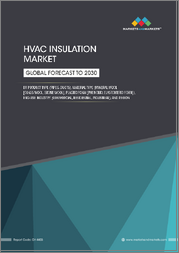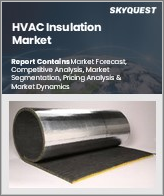
|
시장보고서
상품코드
1775576
HVAC 단열재 시장 : 예측(2025-2030년)HVAC Insulation Market - Forecasts from 2025 to 2030 |
||||||
HVAC 단열재 시장은 CAGR 4.67%로 2025년 66억 5,000만 달러에서 2030년에는 83억 5,500만 달러로 성장할 것으로 예측됩니다.
HVAC 단열재에는 난방, 환기, 공조 시스템이 포함됩니다. HVAC 단열재의 목적은 건물의 안전 대책, 방음, 전력 효율을 높이는 것입니다. HVAC 시스템의 단열재는 열의 이동을 방지합니다. 덕트 내 기류는 적절한 온도 수준으로 유지되어야 하므로 HVAC 시스템에서 덕트 단열은 매우 중요합니다. HVAC 단열재 시스템은 주거, 상업, 산업 분야에서 사용되고 있습니다.
HVAC 단열재 시장 동향:
HVAC 단열재 세계 시장은 주로 건설 산업에서의 채택 증가로 인해 큰 폭의 성장이 예상됩니다. 또한, 자동차 기술의 혁신으로 HVAC 단열재에 대한 수요도 증가하고 있으며, 이는 시장 규모의 확대로 이어지고 있습니다. 아시아태평양은 건설 부문의 급속한 시장 개척으로 인해 가장 큰 시장 점유율을 차지하고 있으며, 예측 기간 동안에도 시장을 주도할 것으로 예상됩니다.
HVAC 단열재 시장 성장요인:
- HVAC 시스템의 혁신
HVAC 단열재 시스템은 과거에 상당한 기술 개발이 이루어졌고, 상당한 에너지 절약과 장비의 기능 향상으로 이어졌습니다. 이러한 기술 혁신은 HVAC 시스템의 수요 증가에 기여하고 있으며, HVAC 단열재 시장의 수요도 증가시키고 있습니다.
미국 메릴랜드에 위치한 Optimized Thermal Systems는 냉매 누출을 현재보다 90%까지 줄일 수 있는 혁신적인 열교환기를 개발하고 있습니다. 이 기술은 냉매가 있어야 할 곳에만 머무르고, 이음새가 적어 주택을 시원하게 유지하고 에너지 지출을 낮추는 데 도움이 됩니다.
플로리다 대학은 온수기, 제습기, 공냉식 유닛을 결합하여 열전달 효율을 향상시키는 프로토타입을 개발하고 있습니다. 이 방법을 통해 실내 제습 관리가 개선되어 쾌적성 향상과 에너지 절약이 크게 향상됩니다.
플로리다의 데이지애널리틱스(Daydia Analytics)는 오크리지 국립연구소(ORNL)와 공동으로 물을 냉매로 사용하는 획기적인 멤브레인 지붕 설치형 에어컨 유닛을 개발하고 있습니다. 이 기술은 고온 다습한 여름밤에 적합하며, 현재 옥상 유닛과 비교하여 30%-50%의 전력을 절약할 수 있습니다.
- 영국의 난방 문제
영국이 직면한 가장 큰 문제 중 하나는 난방으로 인한 이산화탄소 배출량을 줄이는 것입니다. 2008년 기후변화법에 따르면, 영국은 2050년까지 온실가스를 80% 이상 감축할 것을 약속했습니다. 영국의 가스 인프라에 적절한 대안이 없기 때문에 수소, 바이오가스 등 깨끗하고 이산화탄소를 배출하지 않는 대안의 개발이 필요합니다. 영국은 난방으로 인한 배출을 줄이기 위해 저탄소 난방 옵션에 대한 투자를 크게 늘리기 시작했습니다.
이러한 난방 옵션 중 하나는 저탄소 히트 펌프입니다. 저탄소 히트 펌프는 증가하는 기후 변화 문제에 대응하기 위한 효율적이고 효과적인 대안으로 여겨지고 있습니다. 히트 펌프는 인프라 내에서 난방과 냉방을 모두 제공할 수 있는 HVAC 장비의 일종입니다. 히트 펌프는 에너지 효율이 높고 친환경적이기 때문에 화석연료를 태우지 않고도 냉난방을 제공할 수 있습니다. 영국 정부는 2028년까지 60만 대의 히트 펌프를 설치할 계획을 발표했습니다. 이 목표는 영국 정부에 있어 큰 진전이며, HVAC 단열재 시장의 수요를 촉진할 것으로 기대됩니다.
HVAC 단열재 시장의 억제요인:
- 설치 비용
HVAC 시스템은 주거, 공항, 호텔, 산업 등 많은 장소에 냉난방을 제공합니다. 그러나 HVAC 시스템의 초기 설치 비용은 매우 높습니다. HVAC 시스템을 작동하려면 적절한 장비와 도구가 필요합니다.
또한, HVAC 시스템은 고장이 발생하기 쉽고, 지속적인 유지보수가 필요합니다. HVAC 시스템은 외부 온도가 너무 덥거나 추울 경우 고장이 날 수 있으며, 때로는 고가의 수리가 필요할 수도 있습니다. 현재 설치된 에어컨과 히트 펌프 시스템의 50% 이상이 소비자의 전기요금을 최대 30%까지 증가시키고 있습니다.
미국 국립표준기술연구소에 따르면, 그 원인은 부적절한 설치와 장비 고장이라고 합니다. 또한, 미국 에너지 효율 및 재생에너지국은 매년 약 300만 대의 냉난방 장치가 교체되고 있으며, 약 140억 달러가 유지보수 및 수리에 지출되고 있다고 밝혔습니다.
HVAC 단열재 시장 기업:
- Saint-Gobain S.A.
- Owens Corning Corporation
- Rockwool International A/S
- Armacell International S.A.(Ultima Intermediate S.a.r.l.)
- Johns Manville Corporation
- Knauf Insulation
- Kingspan Group PLC
- Arabian Fiberglass Insulation Co., Ltd.
- L'Isolante K-Flex S.p.A.
- Glassrock Insulation Co. S.A.E.
목차
제1장 주요 요약
제2장 시장 현황
- 시장 개요
- 시장 정의
- 조사 범위
- 시장 세분화
제3장 비즈니스 상황
- 시장 성장 촉진요인
- 시장 성장 억제요인
- 시장 기회
- Porter's Five Forces 분석
- 업계 밸류체인 분석
- 정책과 규제
- 전략적 제안
제4장 기술 전망
제5장 HVAC 단열재 시장 : 유형별
- 소개
- 플라스틱 폼
- 미네랄울
- 글라스울
- 락울
- 기타
제6장 HVAC 단열재 시장 : 용도별
- 소개
- 덕트
- 파이프
- 기타
제7장 HVAC 단열재 시장 : 최종사용자별
- 소개
- 주택
- 상업
- 산업
제8장 HVAC 단열재 시장 : 지역별
- 소개
- 북미
- 미국
- 캐나다
- 멕시코
- 남미
- 브라질
- 아르헨티나
- 기타
- 유럽
- 독일
- 프랑스
- 영국
- 스페인
- 기타
- 중동 및 아프리카
- 사우디아라비아
- 아랍에미리트
- 기타
- 아시아태평양
- 중국
- 인도
- 일본
- 한국
- 인도네시아
- 태국
- 기타
제9장 경쟁 환경과 분석
- 주요 기업과 전략 분석
- 시장 점유율 분석
- 합병, 인수, 합의 및 협업
- 경쟁 대시보드
제10장 기업 개요
- Saint-Gobain S.A.
- Owens Corning Corporation
- Rockwool International A/S
- Armacell International S.A.(Ultima Intermediate S.a.r.l.)
- Johns Manville Corporation
- Knauf Insulation
- Kingspan Group PLC
- Arabian Fiberglass Insulation Co., Ltd.
- L'Isolante K-Flex S.p.A.
- Glassrock Insulation Co. S.A.E.
제11장 부록
- 통화
- 가정
- 기준 연도와 예측 연도 타임라인
- 이해관계자에 대한 주요 이점
- 조사 방법
- 약어
The HVAC Insulation Market is expected to grow from US$6.650 billion in 2025 to US$8.355 billion in 2030, at a CAGR of 4.67%.
HVAC insulation includes heating, ventilation, and air conditioning systems. The purpose of HVAC insulation is to increase a building's safety measures, sound insulation, and power efficiency. The insulation in the HVAC system prevents the transfer of heat. The airflow in the ductwork must be maintained at the proper temperature level; hence, duct insulation is critical in the HVAC system. HVAC insulation systems are used in the housing, commercial, and industrial sectors.
HVAC Insulation Market Trends:
The global HVAC insulation market is expected to grow substantially, mainly due to its increasing adoption in the construction industry. The demand for HVAC insulation has also increased due to innovations in automotive technology, leading to an increase in market size. The Asia Pacific region has been reported to have the largest market share, due to the rapid developments in the construction sector, and is expected to continue leading the market in the forecasted period.
HVAC Insulation Market Growth Factors:
- Innovations in HVAC Systems
HVAC insulation systems have seen considerable developments in technology in the past, which have led to significant energy savings and better functioning equipment. Such innovations in technology help in increasing the demand for HVAC systems, and also increase the demand for the HVAC insulation market.
Optimized Thermal Systems in Maryland is working on an innovative heat exchanger that will cut refrigerant leakage by 90% when compared to the present ones. This technology allows the refrigerant to stay where it should, which helps keep houses cool and energy expenditures low, thanks to the fewer joints.
The University of Florida is working on a prototype that combines a water heater, dehumidifier, and air cooling unit to improve heat transfer efficiency. This method improves in-house dehumidification management, resulting in improved comfort and considerable energy savings.
In collaboration with Oak Ridge National Laboratory (ORNL), Dais Analytics in Florida is creating a revolutionary membrane-based roof-mounted air conditioning unit that uses water as a refrigerant. This technology is well-suited for hot, humid summer evenings and might also save 30% - 50% on electricity when compared to current rooftop units.
- The UK's heating problem
One of the most significant problems that the United Kingdom faces is reducing carbon emissions from heat. According to the Climate Change Act 2008, the UK is committed to reducing greenhouse gases by at least 80% by 2050. Since the UK's gas infrastructure does not have any suitable replacement, the gas infrastructure would need the development of clean and carbon-free alternatives, such as hydrogen or biogas. The United Kingdom has started to invest largely in low-carbon heating options to decrease emissions from heating.
One such heating option is the low-carbon heat pump. Low-carbon heat pumps have been regarded as an efficient and effective option to combat the rising climate change problem. Heat pumps are a type of HVAC equipment that can provide both heating and cooling in an infrastructure. Heat pumps are energy-efficient and environmentally friendly, and can provide heating and cooling without having to burn any fossil fuels. The UK government has announced its plan to install 600,000 heat pumps by the year 2028. This target has been regarded as a big step for the UK government and is expected to drive up the demand for the HVAC insulation market.
HVAC Insulation Market Restraints:
- Installation Costs
HVAC systems provide heating and cooling to houses, airports, hotels, industries, and a lot of places. However, the initial installation cost of an HVAC system is extremely high. HVAC systems require proper equipment and tools to operate.
Moreover, HVAC systems are prone to breakdowns and need constant maintenance. An HVAC system may fail if the outside temperature is too hot or too cold, and may sometimes require costly repairs. More than 50% of the air conditioning and heat pump systems installed today increase consumers' utility costs by up to 30%.
According to the National Institute of Standards and Technology, the causes are inadequate installation and malfunctioning equipment. The Office for Energy Efficiency and Renewable Energy also states that roughly 3 million heating and cooling units are replaced each year, and almost US$14 billion is spent on maintenance and repairs.
HVAC Insulation Market Companies:
- Saint-Gobain S.A.
- Owens Corning Corporation
- Rockwool International A/S
- Armacell International S.A. (Ultima Intermediate S.a.r.l.)
- Johns Manville Corporation
- Knauf Insulation
- Kingspan Group PLC
- Arabian Fiberglass Insulation Co., Ltd.
- L'Isolante K-Flex S.p.A.
- Glassrock Insulation Co. S.A.E.
HVAC Insulation Market Segmentation
By Type
- Plastic Foams
- Mineral Wool
- Glass Wool
- Rock Wool
- Others
By Application
- Ducts
- Pipes
- Others
By End-User
- Residential
- Commercial
- Industrial
By Geography
- North America
- USA
- Canada
- Mexico
- South America
- Brazil
- Argentina
- Others
- Europe
- Germany
- France
- United Kingdom
- Spain
- Others
- Middle East and Africa
- Saudi Arabia
- UAE
- Others
- Asia Pacific
- China
- India
- Japan
- South Korea
- Indonesia
- Thailand
- Others
TABLE OF CONTENTS
1. EXECUTIVE SUMMARY
2. MARKET SNAPSHOT
- 2.1. Market Overview
- 2.2. Market Definition
- 2.3. Scope of the Study
- 2.4. Market Segmentation
3. BUSINESS LANDSCAPE
- 3.1. Market Drivers
- 3.2. Market Restraints
- 3.3. Market Opportunities
- 3.4. Porter's Five Forces Analysis
- 3.5. Industry Value Chain Analysis
- 3.6. Policies and Regulations
- 3.7. Strategic Recommendations
4. TECHNOLOGICAL OUTLOOK
5. HVAC INSULATION MARKET BY TYPE
- 5.1. Introduction
- 5.2. Plastic Foam
- 5.3. Mineral Wool
- 5.4. Glass Wool
- 5.5. Rock Wool
- 5.6. Others
6. HVAC INSULATION MARKET BY APPLICATION
- 6.1. Introduction
- 6.2. Ducts
- 6.3. Pipes
- 6.4. Others
7. HVAC INSULATION MARKET BY END-USER
- 7.1. Introduction
- 7.2. Residential
- 7.3. Commercial
- 7.4. Industrial
8. HVAC INSULATION MARKET BY GEOGRAPHY
- 8.1. Introduction
- 8.2. North America
- 8.2.1. USA
- 8.2.2. Canada
- 8.2.3. Mexico
- 8.3. South America
- 8.3.1. Brazil
- 8.3.2. Argentina
- 8.3.3. Others
- 8.4. Europe
- 8.4.1. Germany
- 8.4.2. France
- 8.4.3. United Kingdom
- 8.4.4. Spain
- 8.4.5. Others
- 8.5. Middle East and Africa
- 8.5.1. Saudi Arabia
- 8.5.2. UAE
- 8.5.3. Others
- 8.6. Asia Pacific
- 8.6.1. China
- 8.6.2. India
- 8.6.3. Japan
- 8.6.4. South Korea
- 8.6.5. Indonesia
- 8.6.6. Thailand
- 8.6.7. Others
9. COMPETITIVE ENVIRONMENT AND ANALYSIS
- 9.1. Major Players and Strategy Analysis
- 9.2. Market Share Analysis
- 9.3. Mergers, Acquisitions, Agreements, and Collaborations
- 9.4. Competitive Dashboard
10. COMPANY PROFILES
- 10.1. Saint-Gobain S.A.
- 10.2. Owens Corning Corporation
- 10.3. Rockwool International A/S
- 10.4. Armacell International S.A. (Ultima Intermediate S.a.r.l.)
- 10.5. Johns Manville Corporation
- 10.6. Knauf Insulation
- 10.7. Kingspan Group PLC
- 10.8. Arabian Fiberglass Insulation Co., Ltd.
- 10.9. L'Isolante K-Flex S.p.A.
- 10.10. Glassrock Insulation Co. S.A.E.
11. APPENDIX
- 11.1. Currency
- 11.2. Assumptions
- 11.3. Base and Forecast Years Timeline
- 11.4. Key Benefits for the Stakeholders
- 11.5. Research Methodology
- 11.6. Abbreviations
















